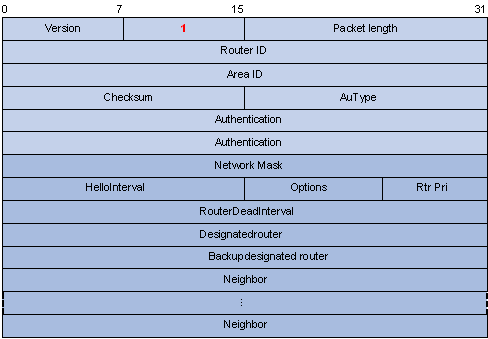OSPF Hello
Sent out through all (included in OSPF) interfaces during initialization phase. On broadcast and p2p links sent to a well known multicast addresses :
- 224.0.0.5 - All OSPF routers
- 224.0.0.6 - DR/BDR routers
Contains:
- Network Mask - subnet mask, on unnumbered and virtual links set to 0.
- Hello Interval - 10sec by default
- Router Dead Interval - 40sec by default.
- Options - commonly used are N/P bit (NSSA support) and E bit (external LSAs support)
- 1st bit value in the Options fiels is reserved for future purpose.
- O bit is utilized for OSPF opaque ( RFC 2370 )
- DC bits has been implemented for demant ciruit capabilities (RFC 1793)
- EA bit is utilized for the external attributes
- N/P has been implemented for NSSA option ( RFC 1587 )
- MC bit designates MOSPF
- E bit - impies that external LSA are permited in this area. E bit is responsible for generating LSA4 by ABR
- T bit has been implemented for Type of Service (default = 0 )
- Router Priority - used in designated/backup router election ( default = 1 ) Higher is better. Priority = 0 means that this router will not contest in DR election.
- Designated Router - address of current DR. 0 by default.
- Backup Designated Router - address of current BDR. 0 by default.
- Neighbor - router IDs of all neighbors on a network segment. Initially empty, filled with RIDs from received Hello messages.
- Area ID
- Authentication
- None - Default.
- Simple - passwords and sent in clear text. This kind of authentication is used mainly to prevent configuration mistakes, it's not secure.
- MD5 - passwords are stored locally and only password's MD5 checksum (which is not easy to reverse calculate) is exchanged. Secure.
In Cisco IOS two routers to establish neighbor relation below Hello values need to match :
- Hello Interval
- Router Dead Interval
- Area ID
- Authentication (Password/MD5)
- Mask of the originating interface on broadcast links






Post a Comment